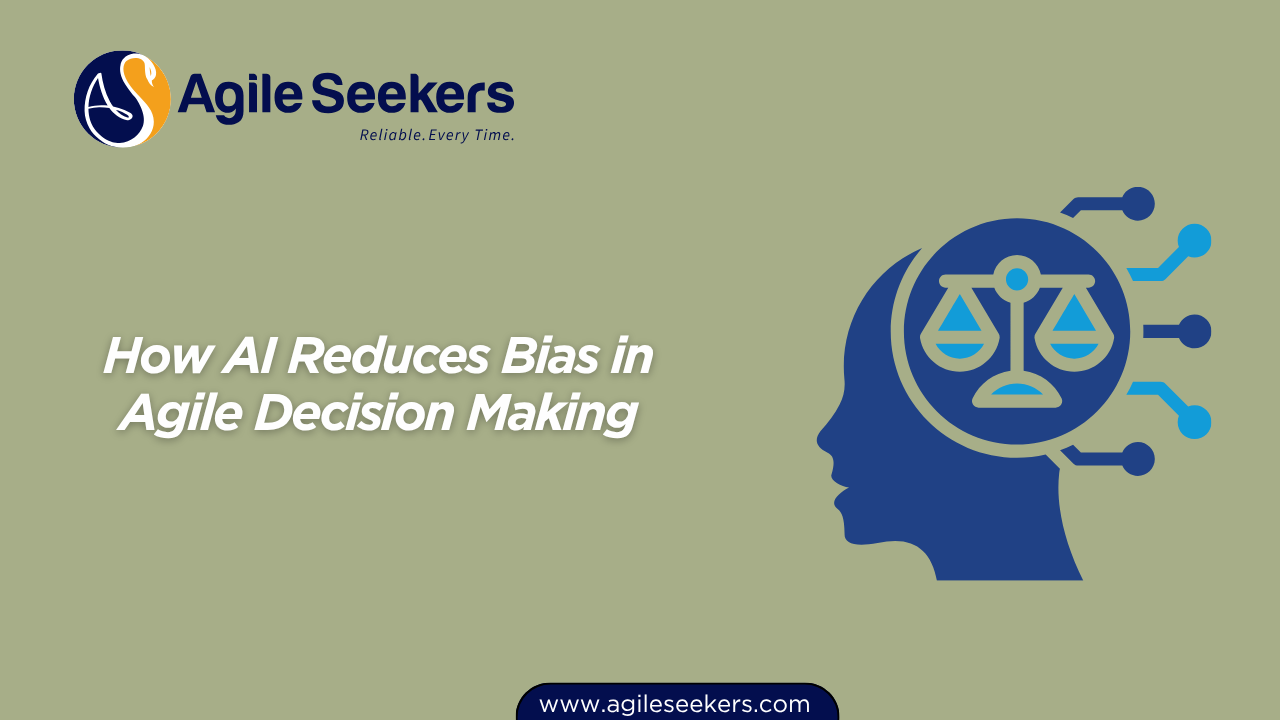How AI Reduces Bias in Agile Decision Making

Agile teams pride themselves on being collaborative, data-informed, and customer-centric. But here’s the catch—humans bring unconscious bias into every sprint, planning session, or backlog grooming call. Even with the best intentions, decisions get skewed. AI can help clean that up.
Let’s break down how AI plays a practical role in reducing bias in Agile decision making—and how teams can start using it right now.
1. Where Bias Creeps into Agile
Before diving into how AI helps, it’s important to call out where bias shows up:
-
Sprint Planning: Over-prioritizing the loudest stakeholder’s feature
-
Backlog Grooming: Skipping tasks that don’t sound urgent
-
User Story Estimation: Anchoring to past assumptions or team member influence
-
Retrospectives: Selective memory or groupthink dominates reflection
-
Hiring or team assignments: Preferring familiarity over diversity or skill match
These are all decision points. And every decision point is a chance for bias to influence outcomes.
2. What AI Actually Brings to the Table
AI doesn’t replace human decision-making—it recalibrates it. It does this by introducing pattern detection, consistent logic, and data-backed feedback loops that humans tend to skip or dilute due to instinct, memory lapses, or pressure.
Here’s how that plays out in Agile environments:
3. AI in Sprint Planning: Prioritization Based on Real Value
Scrum Masters often balance business pressure, team capacity, and guesswork during sprint planning. AI tools trained on velocity, dependencies, and real-time feedback can suggest what work actually brings value based on historical delivery patterns—not stakeholder noise.
Instead of:
“Let’s add this because leadership wants it fast.”
AI says:
“Based on impact-to-effort ratio and team velocity, these 3 stories are more likely to close and deliver value this sprint.”
This kind of prioritization removes emotional weight and puts flow efficiency back at the center.
📚 Want to go deeper into this? Check out our AI-Driven Sprint Planning for Scrum Masters Certification Training
4. Backlog Grooming Without Personal Bias
Human Product Owners tend to favor features they believe in—sometimes overlooking less flashy but technically important work.
AI platforms that scan usage data, customer feedback, and performance metrics can highlight:
-
Features customers are struggling with
-
Underused but expensive-to-maintain components
-
Upcoming dependencies that need prep work
So now, backlog grooming becomes:
“This story improves customer satisfaction by 15% based on last month’s feedback analysis.”
Instead of:
“I think we should do this because it’s important to me.”
That shift is subtle—but powerful.
5. Estimation Gets Real: AI Anchors Teams to Data
Humans are terrible at estimating. It’s science.
Cognitive biases like anchoring, optimism bias, and groupthink skew effort estimation. AI-powered estimation tools aggregate past sprint data to propose more realistic effort points. This anchors the team to historical delivery, not gut feel.
For example:
-
A 5-point story that historically took 3 days but was always rolled over? AI will flag that.
-
A 3-point story with hidden complexity? AI will raise a warning based on similar past cases.
Estimation becomes a feedback loop—not a gamble.
🔍 Interested in AI's role in Scrum Mastery? See our AI for Scrum Masters Training
6. Better Retrospectives Through Sentiment and Pattern Analysis
Bias in retrospectives shows up as selective recall, politeness, or dominant voices skewing the outcome.
AI-powered retrospective tools now use:
-
Sentiment analysis from chat logs or retrospective notes
-
Pattern detection on recurring blockers
-
Engagement scoring to see who speaks up and who stays quiet
These insights surface the truth that often gets missed. Over time, teams can address actual friction—not just the noise that makes it into the room.
7. AI Improves Hiring and Role Allocation in Agile Teams
Even within Agile, team dynamics can be affected by subconscious bias—preferring familiar profiles, prioritizing “culture fit” over skills, or underestimating cross-functional capabilities.
AI tools that anonymize resumes, evaluate skill relevance, and match profiles based on project needs—not names or backgrounds—help reduce bias in forming Agile teams.
Same goes for assigning roles. Instead of choosing a lead because “they’ve been here longest,” AI can highlight who’s best suited based on competency, past outcomes, and collaboration data.
8. How AI Keeps Agile Objective and Focused
Let’s zoom out. Agile thrives on:
-
Quick iterations
-
Customer value
-
Empirical feedback
Bias dilutes all three.
AI strengthens the feedback loop by:
-
Making patterns visible earlier
-
Calling out deviations objectively
-
Enabling decisions based on evidence, not hierarchy or instinct
That’s how Agile stays Agile.
9. Common Tools That Help Remove Bias in Agile
Here’s a short list of AI-backed tools and platforms teams are using:
| Tool | What It Helps With |
|---|---|
| Atlassian Team Insights | Sprint forecasting, team health analytics |
| Jira Smart Assist | AI suggestions for ticket grooming and duplication detection |
| Tara AI | Sprint planning automation using past velocity |
| Parabol + Sentiment AI | Emotion and engagement detection in retrospectives |
| Codex / GitHub Copilot | Objective peer review and code suggestions |
| Receptive.io | Feature prioritization based on real customer data |
You don’t need to overhaul your entire stack—just add one or two pieces where decision bottlenecks exist.
10. Final Word: AI Doesn’t Eliminate Bias Alone—It Exposes It
AI is a mirror, not a magic wand.
When used right, it exposes the flaws in how teams think, plan, and decide. That exposure can be uncomfortable—but it’s where the growth happens.
Agile isn’t just about moving fast. It’s about learning fast. And nothing accelerates learning like confronting your assumptions with cold, hard data.
🔗 Learn More and Upskill
Want to start bringing AI into your Agile practice the right way?
These programs are built for real Scrum teams looking to get sharper, faster, and smarter—without the fluff.
Also read - Why AI Literacy Matters for Scrum Masters in 2025
Also see - Using AI to Analyze Agile Metrics and Trends




















